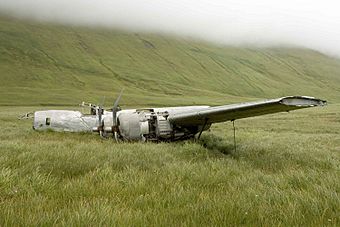Atka B-24D Liberator facts for kids
Quick facts for kids |
|
|
Atka B-24D Liberator
|
|
 |
|
| Nearest city | Atka, Alaska |
|---|---|
| Area | less than one acre |
| Architect | Consolidated Aircraft |
| NRHP reference No. | 79000407 |
| Added to NRHP | 26 July 1979 |
The Atka B-24D Liberator is the wreckage of a large bomber plane found on Atka Island in the Aleutian Islands of Alaska. This plane, a Consolidated B-24D Liberator, was deliberately crash-landed there on December 9, 1942. It is one of only eight D-model Liberators that still exist today, even in parts. The plane, with the serial number 40-2367, was built in 1941. It was on a special mission to check the weather when bad weather stopped it from landing safely at any nearby airports. Only one person was hurt in the crash landing: Brigadier General William E. Lynd, who broke his collarbone.
The crash site was added to the National Register of Historic Places in 1979. Later, in 2008, it became part of the World War II Valor in the Pacific National Monument. In 2019, this monument was renamed the Aleutian Islands World War II National Monument.
Contents
The B-24D Liberator Plane
The B-24 Liberator was a very important aircraft during World War II. It was a heavy bomber used by the United States and its allies. These planes were built by a company called Consolidated Aircraft.
What Made the B-24 Special?
The B-24 Liberator was known for its long range and ability to carry a lot of bombs. It had four engines and a unique wing design. This design helped it fly long distances. The B-24 was used for many different missions. These included bombing enemy targets and scouting for information.
The B-24D Model
The B-24D was an early version of the Liberator. It played a big role in the first years of World War II. The Atka B-24D is special because so few of these early models survived. It helps us remember the planes and people from that time.
The Crash Landing Story
On December 9, 1942, the B-24D Liberator was flying a weather reconnaissance mission. This means it was gathering information about the weather. This was very important for planning military operations.
Why the Plane Crashed
The weather in the Aleutian Islands can be very harsh. On this day, conditions were extremely poor. The crew could not find a safe place to land at any of the airfields. To save the crew, the pilot had to make a controlled crash landing on Atka Island. This was a very risky move.
Who Was On Board?
All but one person on the plane survived the crash without serious injury. Brigadier General William E. Lynd suffered a fractured collarbone. This shows how skilled the pilot was to land the plane safely in such difficult conditions.
Atka Island and World War II
Atka Island is part of the remote Aleutian Islands. These islands stretch across the northern Pacific Ocean. During World War II, the Aleutians became a battleground.
The Aleutian Islands Campaign
Japanese forces invaded some of the Aleutian Islands in 1942. This led to a fierce campaign between American and Japanese forces. The islands were important because of their location. They could be used to launch attacks or defend against them. The presence of the B-24D Liberator wreckage reminds us of this forgotten part of the war.
A Historic Wreckage
The Atka B-24D Liberator wreckage is more than just old metal. It is a historical site. It tells a story about the bravery of the airmen and the challenges of war.
National Register of Historic Places
In 1979, the site was added to the National Register of Historic Places. This means it is recognized as an important part of American history. It helps protect the site for future generations.
National Monument Status
Later, the site became part of a national monument. First, it was the World War II Valor in the Pacific National Monument. Then, it was renamed the Aleutian Islands World War II National Monument. This status gives it even more protection. It also highlights its importance in telling the story of World War II in Alaska.
The wreckage serves as a powerful reminder. It shows the sacrifices made during the war. It also teaches us about the harsh conditions faced by those who served.


